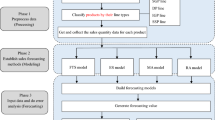Abstract
Forecasting product demand has always been a crucial challenge for managers as they play an important role in making many business critical decisions such as production and inventory planning. These decisions are instrumental in meeting customer demand and ensuring the survival of the organization. This paper introduces a novel Fuzzy Cerebellar-Model-Articulation-Controller (FCMAC) with a Truth Value Restriction (TVR) inference scheme for time-series forecasting and investigates its performance in comparison to established techniques such as the Single Exponential Smoothing, Holt’s Linear Trend, Holt-Winter’s Additive methods, the Box-Jenkin’s ARIMA model, radial basis function networks, and multi-layer perceptrons. Our experiments are conducted on the product demand data from the M3 Competition and the US Census Bureau. The results reveal that the FCMAC model yields lower errors for these data sets. The conditions under which the FCMAC model emerged significantly superior are discussed.
Similar content being viewed by others
Explore related subjects
Discover the latest articles, news and stories from top researchers in related subjects.References
Mentzer J.T., Cox J.E. Jr. (1984) Familiarity, application and performance of sales forecasting techniques. Journal of Forecasting, 3(1):27–36
Makridakis S., Wheelwright S.C. (1989) Forecasting Methods for Management, 5th edn. Wiley, Chichester
Jain C.L. (1991) Ivy league business schools far behind the time. Journal of Business Forecasting, 13(4):2
Fildes R., Hastings R. (1994) The organization and improvement of market forecasting. Journal of the Operational Research Society, 45:1–16
Drury D.H. (1990) Issues in forecasting management. Management International Review, 30(4):317–329
Winklhofer H., Diamantopoulos A., Witt S.F. (1996) Forecasting practice: A review of the empirical literature and agenda for future research. International Journal of Forecasting, 12:193–221
Winters P.R. (1960) Forecasting sales by exponentially weighted moving averages. Management Science, 6:324–342
Box G.E.P., Jenkins G.M. (1976) Time Series Analysis, Forecasting and Control, 2nd edn. Holden Day, San Francisco
Snyder R.D., Koehler A.B., Ord J.K. (2002) Forecasting for inventory control with exponential smoothing. International Journal of Forecasting, 18(1):5–18
Singh, S. and Stuart, E.: A pattern matching tool for time-series forecasting, In: Proceedings of the International Conference on Pattern Recognition, vol. 1, pp. 103–105, 1998
Chung, F. L., Fu, T. C., Luk, R. and Ng, V.: Evolutionary time series segmentation for stock data mining, In: Proceedings of the IEEE International Conference on Data Mining (ICDM), pp. 83–90, 2002.
Balkin S.D., Ord J.K. (2000) Automatic neural network modeling for univariate time series. International Journal of Forecasting, 16(4):509–515
Teo J., Wood D. (2003) Neural network protocols and model performance. Neurocomputing, 55(3):747–753
Chu C.W., Zhang G.P. (2003) A comparative study of linear and nonlinear models for aggregate retail sales forecasting. International Journal of Production Economics, 86(3):217–231
Wen, C. Y. and Yao, M.: A combination of traditional time series forecasting models with fuzzy learning neural networks, In: Proceedings of the International Conference on Machine Learning and Cybernetics, vol. 1, pp. 21–23, 2002.
Albus J.S. (1975) A new approach to manipulator control: the cerebellar model articulation controller (CMAC). Transactions of ASME Journal of Dynamic Systems, Measurements, and Control, 97(3):220–227
Albus J.S. (1975) Data storage in the cerebellar model of articulation controller (CMAC). Transactions of ASME Journal of Dynamic Systems, Measurements, and Control, 97(3):228–233
Ozawa, J., Hayashi, I. and Wakami, N.: Formulation of CMAC-Fuzzy system, In: IEEE international Conference on Fuzzy Systems – Fuzzy-IEEE, pp. 1179–1186, San Diego, CA, 1992.
Makridakis S., Wheelwright S.C., Hyndman R.J. (1998) Forecasting Methods and Applications, 3rd edn. Wiley, New York
Tung, W. L. and Quek, C.: DIC: a novel discrete instrumental clustering technique for the derivation of fuzzy membership functions, In: Proceedings of the 7th Pacific Rim International Conference on Artificial Intelligence: Trends in Artificial Intelligence, 2002.
Lin C.T., Lee C.S.G. (1996) A Neuro-Fuzzy Synergism to Intelligent Systems, Neural Fuzzy Systems. Prentice-Hall, Upper Saddle River, NJ
Quek C., Zhou R.W. (1996) POPFNN: a pseudo outer-product based fuzzy neural IEEE Transaction. Neural Networks 9(9):1569–1581
Zadeh, L. A.: Calculus of fuzzy restrictions, In: Fuzzy sets and Their Applications to and Decision Processes, Academic press, New York, 1–39, 1975.
Ang K., Quek C., Pasquier M. (2003) POPFNN-CRI(S): pseudo outer product based fuzzy neural network using the compositional rule of inference and singleton fuzzifier. IEEE Transactions on Systems, Man and Cybernetics, 33(6):838–849
Turksen I.B., Zhong Z. (1990) An approximate analogical reasoningschema based on measures and interval-valued fuzzy sets. Fuzzy Sets System, 34:323–346
Quek, C. and Zhou, R. W.: POPFNN-AARS(S): A pseudo outer-product based fuzzy neural network, IEEE Transaction Systems, Man & Cybernetics, 29(6) (1999), 859–870.
Lee E.S., Zhu Q. (1995) Fuzzy and Evidence Reasoning. Physica-Verlag, Berlin
Hibon M.M., Makridakis S. (2000) The M3 Competition: results, conclusions and implications. International Journal of Forecasting, 16(4):451–476
http://www.economagic.com
http://www-marketing.wharton.upenn.edu/forecast/software.html#Commercial_Programs
Makridakis S., Wheelwright S.C., McGee V.E. (1983) Forecasting: Methods and Applications, 2nd edn. Wiley, New York
Bishop C.M. (1991) Improving the generalization properties of radial basis function neural networks. Neural Computation, 3(4):579–581
Shi D., Yeung D.S., Gao J. (2005) Sensitivity analysis applied to the construction of radial basis function network. Neural Networks, 18(7):951–957
Author information
Authors and Affiliations
Corresponding author
Rights and permissions
About this article
Cite this article
Shi, D., Quek, C., Tilani, R. et al. Product Demand Forecasting with a Novel Fuzzy CMAC. Neural Process Lett 25, 63–78 (2007). https://doi.org/10.1007/s11063-006-9031-8
Received:
Accepted:
Published:
Issue Date:
DOI: https://doi.org/10.1007/s11063-006-9031-8




